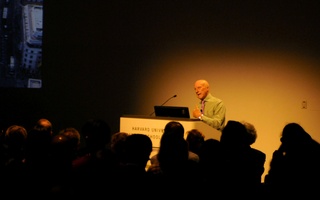{shortcode-8ff3364c424fd0f2f08a8b42feb04121fc7d9009}John Wang ’16 is the current winner of the Radcliffe Institute’s 2016 Public Art Competition. The biennial competition, open to both undergraduate and graduate Harvard students, seeks submissions proposing a site-specific installation for the Susan S. and Kenneth L. Wallach Garden in Radcliffe Yard. This particular piece of land was the second-to-last plot purchased by Radcliffe and has played host to a collection of different buildings over the years. 2017 marks the centennial celebration of Radcliffe’s ownership of the plot.
Wang’s installation, “100+ Years at 73 Brattle,” won in the spring of 2016 and was built over this past summer. This site opened on Sept. 7 and contains a granite outline of former building footprints, commemorating the unique architectural history of the site. His piece also offers the public a space for sitting, gathering, and—he hopes—contemplating.
The Harvard Crimson: What was your academic background during your undergraduate years at Harvard?
John Wang: I studied History of Art and Architecture. In my freshman year, the department started an architectural studies track with the Graduate School of Design, so they started offering studios as part of the track. I was in Social Studies for most of sophomore year, and then I saw the studio offerings for concentrators only and decided to give a try at the studio courses. I ended up really liking it, so I stayed in the concentration.
THC: Do you feel like your background at Harvard prepared you well for this type of project?
JW: It was certainly helpful to have had some studio experience in thinking about design and manipulating a software and doing representations like collage necessary to convey the idea. But I think, now having completed the installation, what I also came to appreciate was the emphasis on history that comes along with being in the HAA department. The installation is driven of course by the history of the site and of buildings that are no longer there.
THC: What led you to submit to the competition?
JW: In my senior year they decided to start offering a J-term workshop for the competition. I think The Radcliffe Institute figured out that most people can design quite well, but they don’t know how to put together a budget that makes sense. And that’s a big part of the competition—how well conceived not only in terms of the design concept but also in terms of how this might actually materialize. Because it’s not just a competition of ideas but also execution.
THC: Where did you get inspiration for the design you proposed?
JW: As part of the workshop, we also had a session in the Schlesinger Library with the librarians there to just get a sense of what Radcliffe is and what it does. In the library, we were shown these historic maps of Cambridge, and it was there that I found out that there was something here before this blank-canvas yard situation. That map was from 1916. After getting the good news of winning the competition, I spent a summer doing more research about the history, and that’s when I found out there are all these maps of Cambridge starting in 1890, 1886, and there’s a whole series of atlases. You can also see the building footprints changing over time, you can see Harvard gradually expanding.
THC: Why did you find the maps an interesting source to draw on for a public art piece?
JW: It’s about history, in a very literal way an excavation ground, kind of digging-into the earth in an experiential way. It speaks to a process of looking and searching and thinking about materials as well. The stones that I proposed, and that we ended up using, were reclaimed granite. So they were granite that had been salvaged or reclaimed from other buildings, building foundations, bridges, pavings. These blocks of granite that had clearly been used before, there are drill marks and rust all over it here and there.
THC: How do you envision the community interacting with it?
JW: This is a hard question for me, because I don’t like to give a definitive take on the thing. I think the excitement for me in looking at something is to figure out for myself what it is about and to really let it be more opened-ended. When I designed it, I really imagined it to be more of a contemplative space. Originally when I designed it there was no wood, there was no garden, it was just stone. So it’s a very solemn space. Now it’s very lively—it’s got plants, there are bees flying around it all the time. The way the wood deck is shaped, it suggests a theater space, it suggests a performance space. And actually at the opening ceremony yesterday, one of the fellows, a playwright, walked past it and said she could write something and have it be performed right there.
—Staff writer Rebecca H. Dolan can be reached at rebecca.dolan@thecrimson.com.
Read more in Arts
After Hours at the Museums: Color, Cocktails, CelebrationRecommended Articles
-
Architects Launch Competition To Design Project for HomelessA local architects' organization yesterday kicked off a competition for graduate architecture students to design a public housing complex that
-
THE COLLEGE COMEDY.'T WAS midway in my Senior year, one night I ground up Dante for Italian 3, When sleep, the gentle
-
Senior Class NoticesAt a meeting of the Senior Class Button Committee held yesterday afternoon it was decided to hold a competition among
-
 Architect Norman Foster Lectures at School of Design
Architect Norman Foster Lectures at School of Design -
 Arts Asks: Santiago Mota
Arts Asks: Santiago Mota













